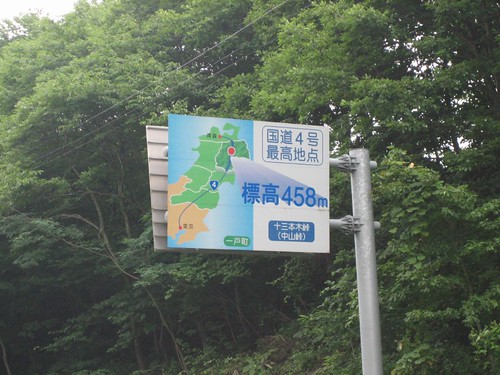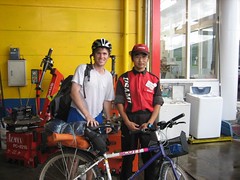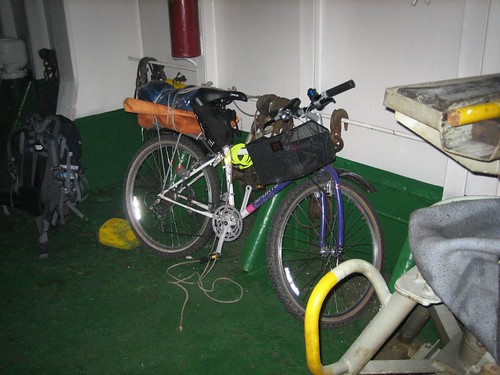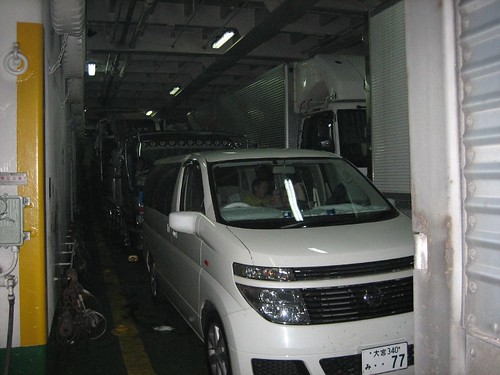There isn't actually so much to write about this day. I rode 200 kilometers in 16.5 hours. It was brutal and I did not do anything very fun, I just rode and rested. I am writing about this so any novice cyclist can learn from my experience or any somewhat experienced cyclist can laugh at me.
As I mentioned in my previous post, I had originally planned to go from Morioka to Aomori City in 2 days leaving Morioka on August 10 and arriving on August 11. From Aomori I planned on taking a ferry to Hakodate. Because the ferries were going to be completely booked from August 11 and I would have a very difficult time getting my bicycle onto the ferry I decided to get to Aomori city on August 10.
I planned to leave my house at 3:30AM on that day and figured I could do 200 kilometers in about 12 hours averaging about 20 kilometers an hour and using 2 hours for rest. I imagined myself arriving in Aomori at about 4PM and being in Hakodate that night drinking beer and eating sushi with friends. Boy, was I wrong.
I got out of bed at 5 AM and it took me about an hour and half to get
 ready for the journey. I left my house at 6:30 without eating breakfast. My plan was to take route 4 all the way from Morioka to Aomori. In a little over an hour I had gone about 20 kilometers. I was not going as fast as I wanted but I was happy with my progress I stopped off at a Daily Yamazaki convenience store and ate breakfast and then was back on my way. In not so much time I was in Iwate-cho, 40 kilometers from Morioka. Soon after passing through Iwate-cho I experienced the 奥中山高原 or the Okunaka Mountain High Plains. The sign on the right marks the highest point on route 4, 458 meters above sea level. At this point I thought that I had overcome the hardest stretch of the trip. That was not to be the case.
ready for the journey. I left my house at 6:30 without eating breakfast. My plan was to take route 4 all the way from Morioka to Aomori. In a little over an hour I had gone about 20 kilometers. I was not going as fast as I wanted but I was happy with my progress I stopped off at a Daily Yamazaki convenience store and ate breakfast and then was back on my way. In not so much time I was in Iwate-cho, 40 kilometers from Morioka. Soon after passing through Iwate-cho I experienced the 奥中山高原 or the Okunaka Mountain High Plains. The sign on the right marks the highest point on route 4, 458 meters above sea level. At this point I thought that I had overcome the hardest stretch of the trip. That was not to be the case.After passing through Okunaka Kougen I arrived at 一戸 or ichinohe. "Ichi" means one and "he" means "door". Interestingly, there also exists a "2 no he" a "3 no he" a "5 no he" a "6 no he" a "7 no he", an "8 no he" and a "9 no he". I would have the honor of passing through all the "no hes" except for "8 no he" and "9 no he". Throughout the day, I wondered what the founding fathers of Iwate Prefecture and Aomori Prefecture were thinking when they were naming the towns. There must be some interesting history there.
At Ichinohe, the rain changed from drizzle to downpour. Because I was in a hurry to get to Aomori, I decided to go on in the pouring rain. As I was cycling up a hill I saw a cyclist standing under a tree waiting for the rain to stop. We made eye contact and he looked at me as if I was an idiot for cycling in the pouring rain. In this pouring rain, my feet and undergarments became soaked and would remain damp the rest of the 16 hours. When cycling, bring good water-resistant apparel as well as wear water resistant shoes or avoid cycling in a downpour.
After Ichinohe I passed through Ninohe (2 no he). As I was leaving Ninohe, I had gone about 80 kilometers and it was 11AM. I was feeling confident that I would be in Aomori city by 5PM. Unfortunately, 5 kilometers outside of central Ninohe I had a setback. As I was cycling up a hill, all of a sudden the back of the bicycle felt heavy. I looked down and realized that I had a flat tire. I got off my bicycle, tried to pump up the tire and realized that the hole in the tube was too big for any air to stay in the tire for a period of time. I took my spare tube out of my bag but soon realized that the valve of my spare tube was incompatible with my pump. According to the Japan Cycling website, most bicycles in Japan use a "Woods valve" (in Japanese the notation for this is 英) while the international standard is a "French" (仏)or "American valve" (米). The tube on my bike was an American valve so I had bought a pump compatible with that kind of valve. The lesson I learned is that when cycling in Japan bring a pump that can do Woods as well as French and American valves.
I
 was closer to Ninohe than Sannohe (3 no he), but did not want to walk in the oppostite direction so I decided to walk towards san no he and pray that I find a bicycle store along the way. After walking about a kilometer, I came across a gas station in the middle of no where. I explained to them my predicament and they told me that the nearest bicycle store was 10 kilometers away. Of course, they did not sell bicycle pumps. I asked them if they could pump up the tire and they said yes. I then asked them if they change the tube and they said yes. So I got to sit in the waiting room of the gas station and have a coke as the attendants fixed my bicycle tire. As I was sitting in the waiting room, I saw the cyclist I saw under a tree in Ichinohe pass the gas station. They also patched my tube for me and informed me that it had been punctured by a nail. Getting my tire fixed cost me 1050 Yen. It was money very well spent as I felt well rested and ready to cycle the remaining 118 kilometers. Later, when I recounted the story to a Japanese friend he said that the reason why the gas station helped me was because I was a foreigner and they might have blown off a normal Japanese. I don't know, though, these people acted like cyclists had come to them before when they were in trouble.
was closer to Ninohe than Sannohe (3 no he), but did not want to walk in the oppostite direction so I decided to walk towards san no he and pray that I find a bicycle store along the way. After walking about a kilometer, I came across a gas station in the middle of no where. I explained to them my predicament and they told me that the nearest bicycle store was 10 kilometers away. Of course, they did not sell bicycle pumps. I asked them if they could pump up the tire and they said yes. I then asked them if they change the tube and they said yes. So I got to sit in the waiting room of the gas station and have a coke as the attendants fixed my bicycle tire. As I was sitting in the waiting room, I saw the cyclist I saw under a tree in Ichinohe pass the gas station. They also patched my tube for me and informed me that it had been punctured by a nail. Getting my tire fixed cost me 1050 Yen. It was money very well spent as I felt well rested and ready to cycle the remaining 118 kilometers. Later, when I recounted the story to a Japanese friend he said that the reason why the gas station helped me was because I was a foreigner and they might have blown off a normal Japanese. I don't know, though, these people acted like cyclists had come to them before when they were in trouble.I left the gas station at close to 12PM. About 45 minutes later I was leaving sannohe (3 no he) when it started to pour. I was fortunate enough to see a michinoeki or "road station" which is similar to a highway rest stop. I stopped in the michinoeki, parked my bicycle and saw the cyclist who I had seen in under a tree in Ichinohe and pass me at the gas station between ninohe and sannohe, sitting under the porch of the rest area house sipping tea. I sat next to him and introduced myself. He lived near Morioka and was on his way to Hachinohe, a city about 30 kilometers from our present position. When I told him my destination and plan he called it 無謀 (mubou) which means foolhardy. A woman working at the rest area house overheard our conversation and gave me a cup of green tea. After about 10 minutes the rain stopped, and I felt good and ready to go the remaining 95 kilometers. It was about 1:30 PM.
After 10 minutes of riding the sun came out. I soon left sannohe and entered gonohe (5 no he). There is no 4 no he because the pronunciation for 4 sounds like the character for "death" and thus it is considered bad luck. At gonohe I encountered hills and mountains that went on for many kilometers. It was at about this time that I started to feel extremely fatigued. It seemed like everything was uphill and it never ended. I could have stopped in central gonohe but decided to continue. I thought that I could make it to Towada city which was about 20 kilometers away. The hills, though, became mountains, and my progress became agonizingly slow. At about 3PM I pulled into the Towada michi no eki barely able to stand. I ate a quick lunch and fell asleep for an hour. I woke up at 4:15 PM and left the michinoeki at 4:30 PM. I still had 80 kilomters to go to Aomori City. Between 6:30 AM and 11AM I had manage to cycle 80 kilometers. Between 12PM and 3PM, though, I had only managed 40 kilometers. My pace was slowing down and I was feeling tired even after my hour long nap. I had 80 kilometers to go, it was 4:30 PM and it would be dark before 7PM.
To make a long story short. The remaining 80 kilometers were hilly but not mountainous. I had to rest about 10 minutes for every hour I rode. Also, once it became dark my pace slowed even more. I made it into Aomori City at about 10:30 and then got lost. Route 4 approaching Aomori City is not bicycle friendly and I would recommend that cyclists try to find an alternative route into the city if possible. After asking for directions at a police box I was able to find the ferry terminal at about 11:30PM.
I had made a ferry reservation for early morning (5AM) for myself on August 11. They told me that I would be unable to take my bicycle so I had bought a bag (輪行 - rinkou)to put my bicycle in so that I could carry it on the ferry as luggage. When I got to the ticket booth at the ferry terminal I asked the agent if I could change my reservation and ride on the 1AM ferry. He looked at me as if I was crazy and informed me that the 1AM ferry was completely booked and that all the ferries leaving the next day and the day after were completely booked. He told me that if I wished they could put me on the wait list for the 1AM ferry and that I should go to the "waiting list" line. When I spoke to the agent at the waiting list line he told me that I could ride on the 1AM ferry with no problem. I asked him if I could also bring my bicycle on the ferry and he said no problem, I could put it together with the motorbikes. At that moment, I wondered why in the hell I had spent 12,000 yen for a bicycle bag. (The bag turned out to be very useful when I packed the bicycle in my car.)
Boarding the ferry was pretty interesting. I boarded the ferry together with the motorcycles,
 pedaling my bicycle into the ferry while the other bikes motored in. My bicycle, Sheila, was tied to the wall of the garage as the picture to the right shows. Disembarking from the ferry was a little unpleasant. About 20 minutes before the ferry docked, all drivers, bikers and cyclists were instructed to go into the garage and wait in their cars or
pedaling my bicycle into the ferry while the other bikes motored in. My bicycle, Sheila, was tied to the wall of the garage as the picture to the right shows. Disembarking from the ferry was a little unpleasant. About 20 minutes before the ferry docked, all drivers, bikers and cyclists were instructed to go into the garage and wait in their cars or  on their bikes. When I got into the garage, all the cars and trucks had their engines running and I felt like I would die from carbon monoxide poisoning. I took a picture of the scene and you can see it on the left. Eventually, the garage doors opened and I pedaled off the ferry between one big white truck and one dark one. I had made it to Hakodate. It was 5AM and my friend Bill was there to greet me. I decided the first thing I would do was go to Hakodate's Morning Market and eat sushi.
on their bikes. When I got into the garage, all the cars and trucks had their engines running and I felt like I would die from carbon monoxide poisoning. I took a picture of the scene and you can see it on the left. Eventually, the garage doors opened and I pedaled off the ferry between one big white truck and one dark one. I had made it to Hakodate. It was 5AM and my friend Bill was there to greet me. I decided the first thing I would do was go to Hakodate's Morning Market and eat sushi.To be continued....
No comments:
Post a Comment